The Consequences of Stress in the Workplace: How It Impacts Employees and Business Performance
Last Updated Nov 7, 2025

Your team looks busy. But underneath the hustle, stress might be silently eroding your business.
When stress becomes part of the daily grind, it doesn’t just stay in people’s heads. It slips into their work—missed deadlines, rising sick days, and growing disengagement. Left unchecked, it snowballs into burnout, turnover, and a toxic culture that’s hard to reverse.
And it’s more than just a people problem. Stress hits profits. From soaring healthcare costs to shrinking productivity, the impact cuts deep and wide.
Ready to stop the stress spiral before it hits your bottom line? Uncover the hidden costs, root causes, and proven strategies to protect your people—and your performance.
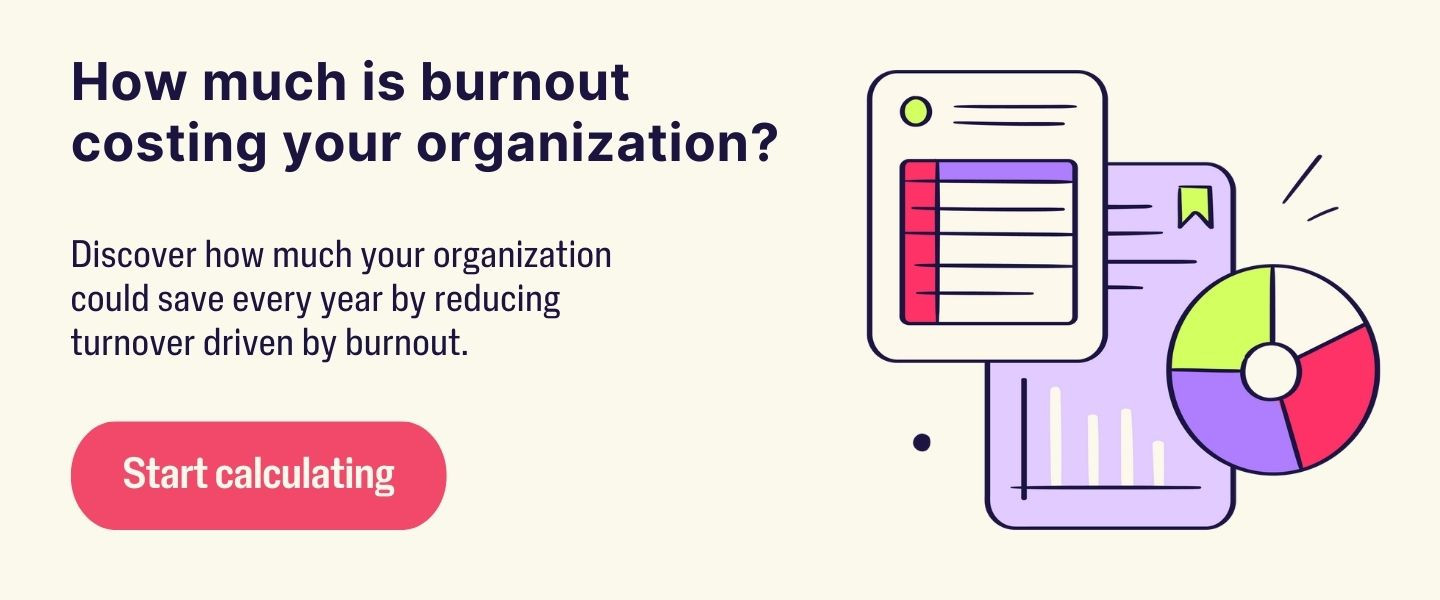
What You'll Learn
- How chronic workplace stress leads to lower productivity, increased errors, absenteeism, and turnover, driving significant business costs.
- The physical, emotional, and behavioral signs of stress that can erode employee wellbeing, engagement, and workplace culture.
- The top five causes of workplace stress—including heavy workloads, lack of autonomy, and poor leadership—and practical ways to address each.
- How cultivating a wellbeing-focused culture can improve resilience, retention, and ROI while reducing burnout.
- Step-by-step methods to identify, measure, and address stress before it escalates into more serious organizational challenges.
How Workplace Stress Impacts Business Performance in 2025
Stress in the workplace isn't always visible, but it can eventually create real challenges for a business. When employees are stressed, their performance often slips and that can snowball into bigger business challenges. Consequences of stress at work can lead to:
Lower Output and Increased Errors
Chronic stress chips away at employees’ focus, energy, and motivation. This results in lower output, missed deadlines, and costly mistakes. In high-stakes environments, such as healthcare or logistics, even small slip-ups can lead to serious consequences.
Higher Sick Days and Quitting Rates
Stress isn’t just a fleeting emotion. It’s a psychological and physiological response that can lead to depression, anxiety, employee burnout, and sleep disorders. This can lead to employees taking more frequent sick days, needing longer recovery periods, and sometimes quitting altogether. According to the American Institute of Stress, 40% of job turnover is due to stress, and approximately 1 million U.S. workers are absent from work every day because of stress.
Financial Costs to the Business
Stress can affect the bottom line in several ways. Stress-related illnesses like hypertension and anxiety can drive up employer healthcare costs. According to the National Institute for Occupational Safety and Health (NIOSH), healthcare expenditures are almost 50% greater for workers who report high levels of stress.
Turnover resulting from burnout can also lead to increased hiring and onboarding costs. Meanwhile, presenteeism, which occurs when employees are physically present but mentally disengaged, can result in significant productivity losses.
Chronic stress doesn’t fade on its own. Here’s how to recognize and prevent its lasting effects.
What Are the Consequences of Stress in the Workplace?
Workplace stress affects employees at every level and has far-reaching consequences for the organization's overall health. Employees will feel physical, emotional, and psychological effects that can change behavior, reduce productivity, and increase employee turnover and absenteeism.
- Physical Effects
Stress isn’t just a feeling. The impact of stress at work can have severe physical health consequences that may lead to long-term health problems. Chronically stressed employees may experience:
- Headaches that linger or come on suddenly during busy periods
- Muscle tension or pain, especially in the shoulders, neck, and back
- Fatigue, even after a full night’s sleep
- Digestive problems, such as appetite changes and stomach pain
- Insomnia or difficulty sleeping, which makes recovery even harder
These symptoms don’t just make life more difficult. They’re warning signs. Over time, stress can lead to more serious conditions like heart disease, obesity, and autoimmune disorders. When employees are physically unwell, they will have a lower chance of showing up fully at work, both mentally and emotionally.
- Emotional and Psychological Effects
Stress can also lead to severe emotional and psychological effects. Employees may experience:
- Anxiety about tasks they used to tackle with ease
- Depression about having to clock into work, where they feel drained
- Mood swings, especially when dealing with strenuous tasks
- Irritability, which could lead to snapping at coworkers or withdrawing from conversations
- Burnout that may come with a sense of hopelessness or detachment
These emotional challenges can quietly erode job satisfaction, making everyday tasks feel overwhelming. When people are struggling mentally, it’s not just their work that suffers. Their confidence, relationships, and overall workplace quality of life will also decrease, causing them to withdraw more at work and possibly even quit.
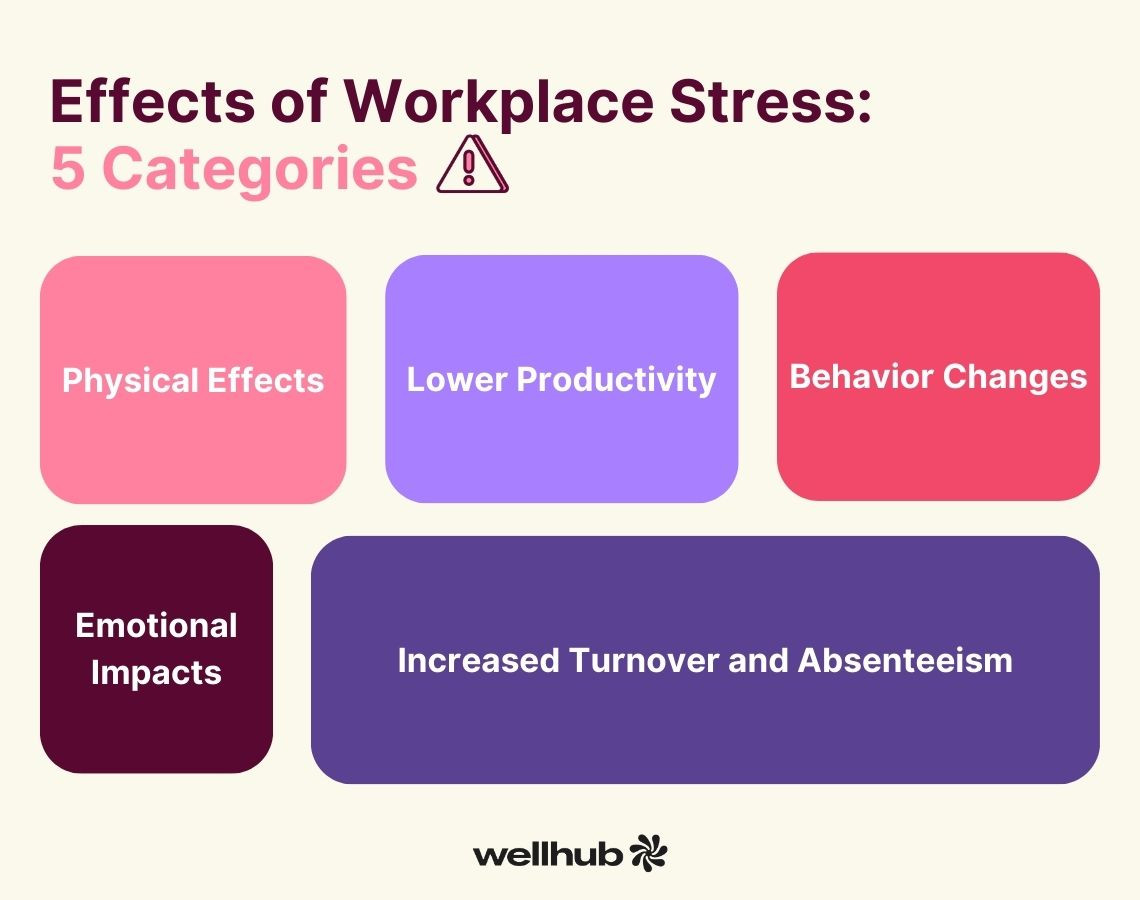
- Behavioral Changes
Stress often causes noticeable changes in an employee's behavior, including:
- Withdrawal from team activities or social interactions
- Increased conflict, frustration, or passive-aggressive behavior
- Reduced employee engagement or motivation, even for once-engaged and high-performing employees
- Unhealthy coping mechanisms, like excessive drinking, smoking, skipping meals, and substance abuse
These changes don’t just affect individuals. They ripple through teams, causing morale to dip, collaboration to suffer, and the workplace to feel tense or unpredictable.
- Reduced Productivity and Efficiency
When stress takes over, even the most focused employees can struggle to stay on track. This often causes:
- Missed deadlines and incomplete projects
- Lower-quality work with more oversights and errors, which can even lead to potential lawsuits
- Mental fatigue, where even simple tasks feel exhausting
And the worst part? The cycle feeds itself. Stress causes underperformance, which leads to more stress.
- Increased Employee Turnover and Absenteeism
When the workplace feels like a pressure cooker, people start looking for an exit. Chronic stress leads employees to question whether their job is sustainable, and many decide it’s not worth the emotional and physical toll. Meanwhile, others may not quit but take more sick days. This leads to:
- Disrupted workflows as teams scramble to cover for absent colleagues
- Loss of institutional knowledge when experienced employees leave
- Higher recruitment costs as companies spend time and money replacing burned-out staff
Moreover, high turnover rates can damage a company’s reputation. When people find out through word-of-mouth, social media, or sites like Glassdoor that a company can’t hold on to staff, people will lose interest in applying and it will be harder to attract top talent.
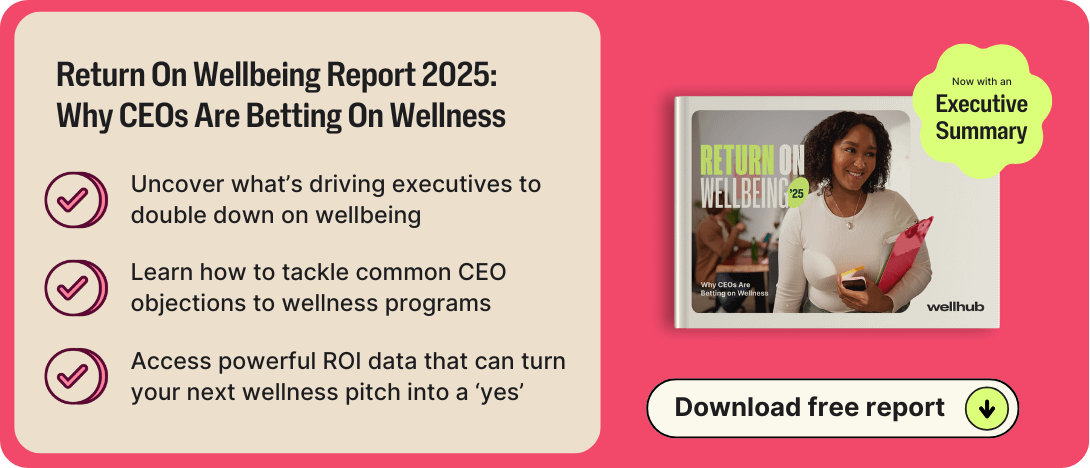
5 Key Causes of Workplace Stress (And How To Address Each One)
Stress isn’t just a personal problem–it’s a business-critical one. In Wellhub’s State of Work-Life Wellness 2025 study, 47% of employees said that work stress is actively degrading their mental wellbeing. That’s nearly half of your workforce operating at reduced mental capacity—every single day.
- Heavy Workloads and Unrealistic Expectations
Let’s be honest: overstuffed task lists and nonstop “ASAPs” are fast tracks to burnout. When the work never ends and recognition is scarce, employees check out mentally—and then physically.
What you can do:
- Review project timelines and workload distribution quarterly.
- Provide training on prioritization and time management.
- Build slack time into sprints or workflows so teams can breathe.
- Lack of Autonomy and Control
People thrive when they feel trusted. Micromanagement strips away that trust—and agency. Employees who feel they can’t influence how they work are more likely to disengage.
What you can do:
- Encourage managers to set goals, not methods.
- Invite employees to co-create their KPIs.
- Train leaders on empowerment-oriented management styles.
Stress is costing companies more than ever. Find out how tostop it before it harms performance.
- Unclear Roles and Responsibilities
Confusion breeds stress. When employees don’t know where their job starts and ends—or how their work contributes to team goals—they feel anxious and ineffective.
What you can do:
- Create and regularly update role clarity documents.
- Include a 30/60/90-day roadmap for every position.
- Use onboarding and inboarding to reinforce clarity during transitions.
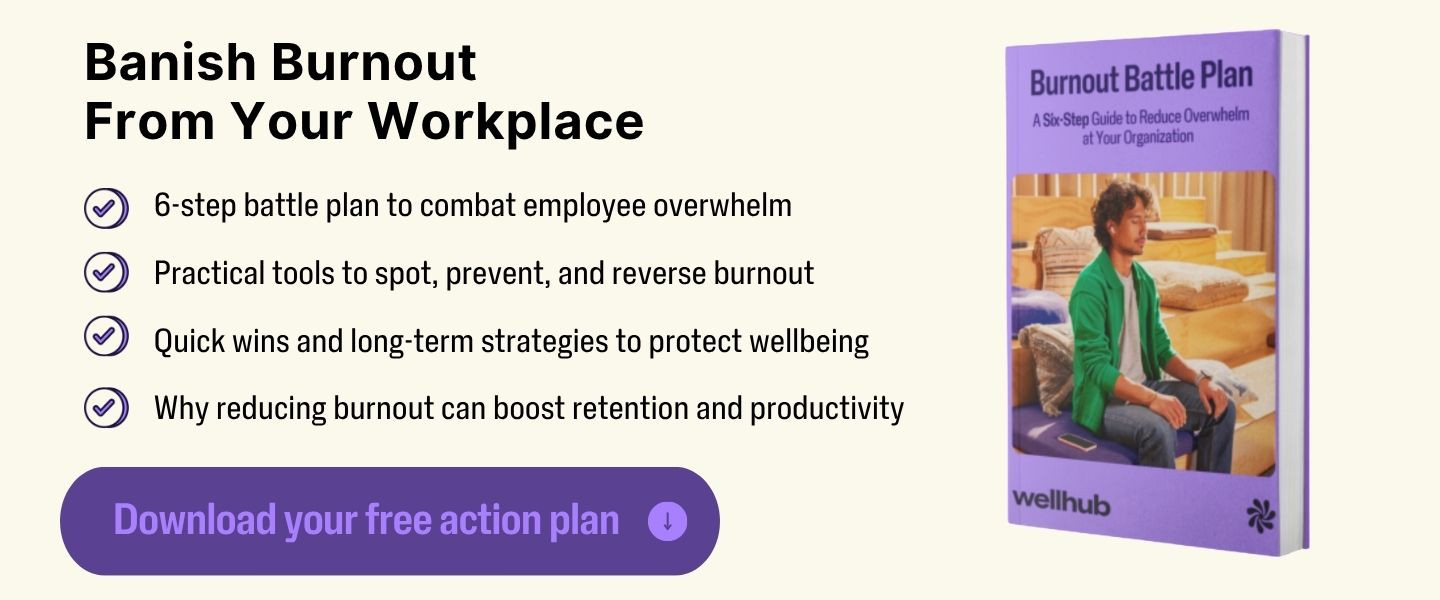
- Poor Leadership and Communication
Inconsistent direction, mixed messages, and reactive feedback hurt team trust. And the longer it goes unchecked, the harder it is to repair.
What you can do:
- Offer leadership coaching and communication training.
- Standardize one-on-one check-ins.
- Use pulse surveys to spot early signs of leadership issues.
- Job Insecurity and Organizational Uncertainty
When layoffs loom and communication is cryptic, employees begin emotionally detaching to protect themselves. That disconnection is stressful—and contagious.
What you can do:
- Lead with transparency, especially during change.
- Build feedback loops into major org transitions.
- Reinforce company values and individual impact regularly.
Don’t let stress derail your workforce. Act now with these 9 strategies to reduce workplace stress.
The Culture-Stress Feedback Loop
Stress isn’t just influenced by company culture—it shapes it.
When stress becomes the norm, the culture suffers. People stop asking for help. Long hours become a badge of honor. Silence replaces feedback. And before you know it, your once-collaborative team is working in survival mode.
This creates a culture where:
- Morale drops
- Trust evaporates
- Conflict increases
- Engagement plummets
But the good news? Culture can also be your best line of defense.
When you build a supportive culture—one that values wellbeing as much as performance—employees can weather tough times with resilience. In fact, 73% of CEOs say their wellness initiatives are very or extremely impactful in fostering resilience in employees.
How Wellbeing Culture Combats Stress
Let’s get tactical. A wellbeing-focused culture doesn’t mean ping-pong tables and snack bars. It means creating conditions where people feel psychologically safe, physically supported, and emotionally seen.
Here’s what that looks like in action:
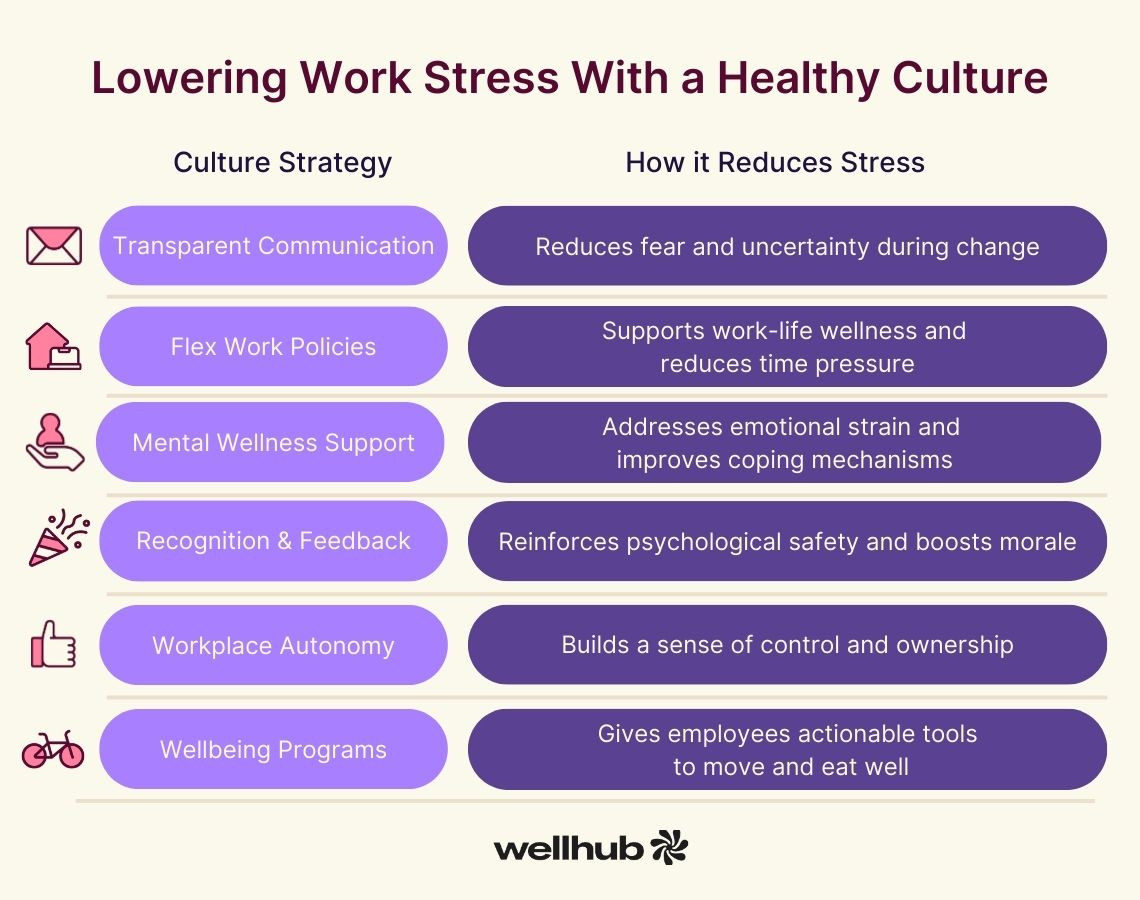
And guess what? This isn’t just a feel-good exercise. Companies with wellness programs see serious ROI:
- 67% of CEOs say their wellness program significantly reduces absenteeism.
- 73% say wellbeing programs improve retention.
- 82% report a positive ROI from their wellness programs.
How to Identify and Measure Workplace Stress (Step by Step)
If you want to reduce stress, you need to know where it’s coming from. The earlier you spot it, the faster you can step in—and prevent burnout before it starts. Here’s your action plan for detecting signs of employee stress across your organization.
Step 1: Recognize the Warning Signs
Stress doesn’t always wave a red flag. It often shows up quietly—until it doesn’t. Start by training people managers and HR partners to spot these early behavioral indicators:
- Slipping performance: Missed deadlines, errors, or decreased productivity
- Absenteeism or lateness: Repeated tardiness or calling in sick more frequently
- Withdrawal: Lower participation in meetings or team activities
- Emotional shifts: Increased frustration, irritability, or tearfulness
- Changes in communication: Less responsive, more passive, or overly reactive
Think of these as early “check engine” lights. They don’t always mean something is wrong—but they’re always worth a closer look.
Step 2: Use Tools to Capture Employee Sentiment
Observations are important, but they only show part of the picture. To understand what’s happening across your workforce, supplement manager insights with data-driven tool
| Tool | How It Helps |
|---|---|
| Anonymous surveys | Reveal how employees feel without fear of judgment |
| Pulse checks | Offer a quick, repeatable way to monitor real-time mood |
| Exit interviews | Identify stress-related turnover patterns |
| Wellbeing platforms | Spot behavioral changes and engagement dips early |
💡 Pro Tip: Combine tools to get a 360° view. For example, a spike in missed meetings and a dip in wellbeing platform engagement might signal a team under pressure.
Step 3: Share Findings and Lead with Empathy
The next step is where the magic happens: turning insights into action.
Start by sharing what you’ve learned—transparently and compassionately. Employees want to know you see them, you hear them, and you care. Then, partner with people managers to address root causes of stress.
That might include:
- Redistributing workloads
- Updating job expectations
- Adjusting benefits or wellness offerings
- Creating space for open conversations
Remember: 47% of employees say work stress is degrading their mental wellbeing. That means nearly half of your workforce may be silently struggling. Identifying the issue is the first—and most important—step toward changing it.
Effective Strategies to Manage and Reduce Workplace Stress
The consequences of stress at work are significant, ranging from decreased productivity and higher absenteeism to increased turnover and rising health issues. These challenges impact both employee wellbeing and overall business performance.
Addressing stress requires a thoughtful, proactive approach. Here’s how employers can measure and prevent burnout and support their teams.
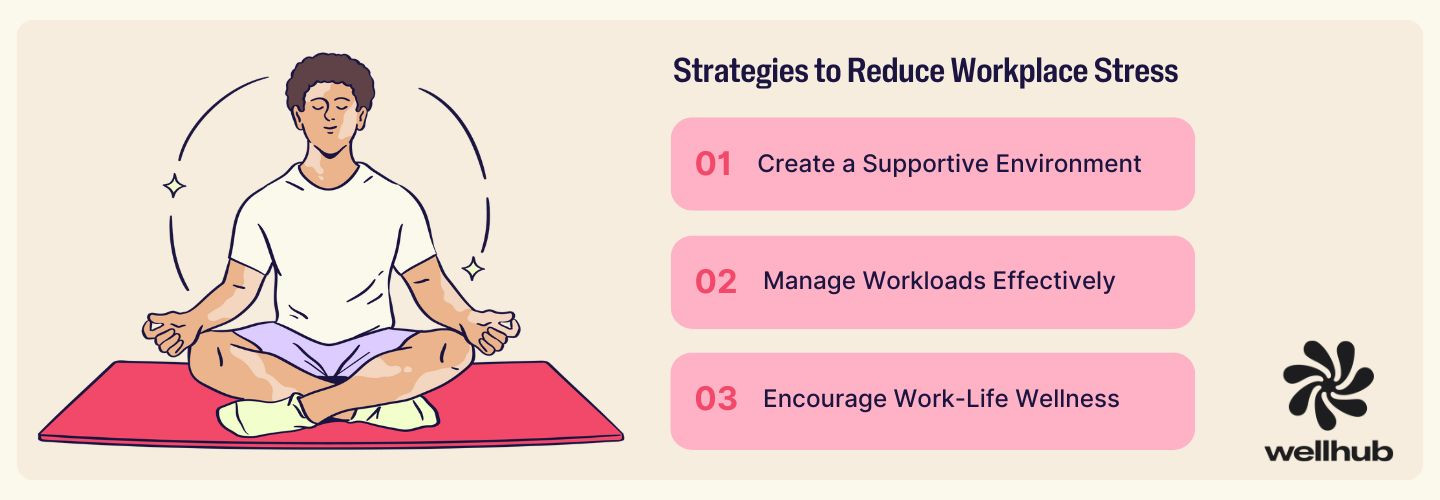
Create a Supportive Work Environment
Start by making it okay to talk about stress. Normalize conversations around workplace wellness, provide access to employee wellbeing programs, and train leaders to respond with empathy.
For example, you can:
- Offer mental health days that encourage rest and recovery
- Provide mental health support like counseling programs
- Add employee wellness activities, such as stress management programs, sleep tracking challenges, and debt management resources
- Establish employee resource groups for peer support
- Train managers to recognize and respond to signs of distress
- Give employees several days a year for stress leave
When people feel seen and supported, they’re much more likely to stay engaged and resilient.
Implement Workload Management Techniques
Help employees manage their time and energy wisely by:
- Using project management tools to track tasks and avoid overload
- Encouraging regular breaks, not just during lunch
- Setting realistic deadlines and expectations that allow for flexibility
Flexible work arrangements, like remote work or flex hours, can also make a big difference.
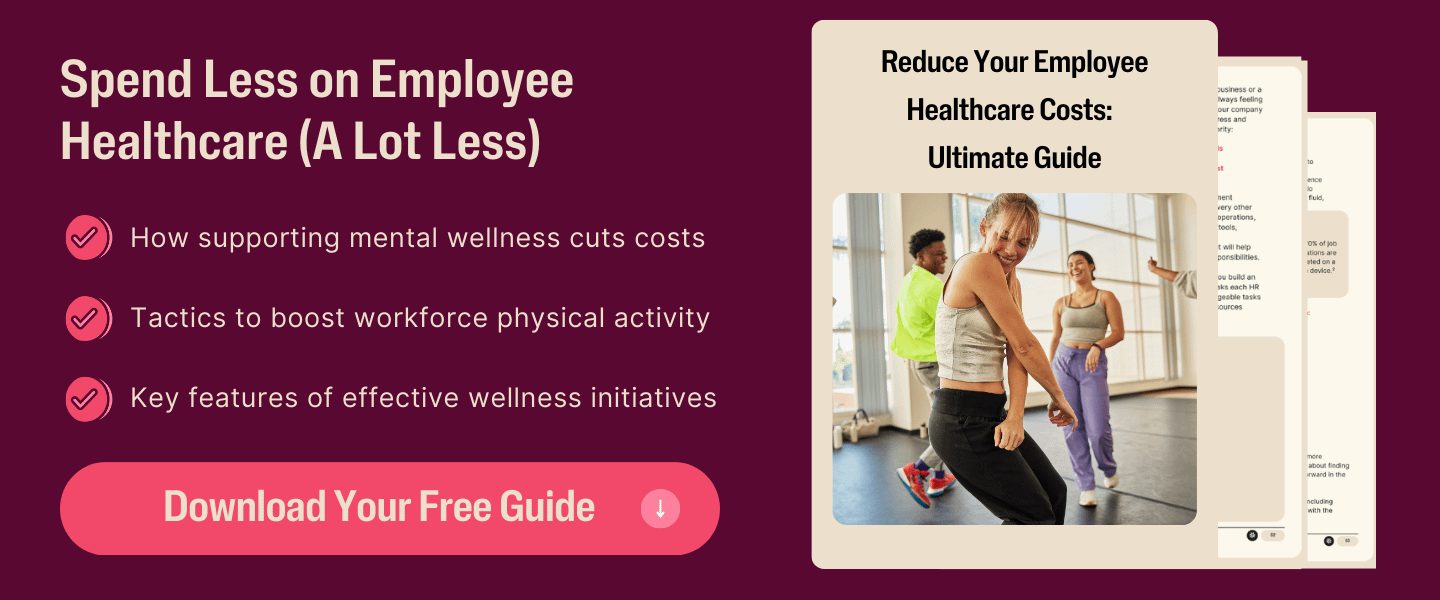
Encourage Work-Life Wellness
Work shouldn’t be the single defining factor of people’s lives. Support balance by offering:
- Wellness stipends for therapy, fitness, or hobbies
- Fitness and mindfulness programs to improve focus and reduce anxiety
- Nutrition and sleep resources, which can help improve health, wellbeing, and productivity
- Reimbursement for other work-life wellness essentials, such as ergonomic home office setups, digital detox challenges, or guided meditation subscriptions
- “No meeting” days or flexible Fridays to help employees recharge and feel trusted to manage their own time
Also, make sure employees can truly disconnect during Paid Time Off (PTO), and avoid after-hours communications unless it’s urgent.
How Leadership Can Influence Stress Levels
Leadership style sets the tone of the company culture. Supportive, empathetic managers can be a powerful buffer against workplace stress, while poor leadership can amplify it.
Emerging research highlights the significant influence that managers have. For example, an HRMorning report found that 76% of employees with empathetic managers are engaged at work. Additionally, employees who trust their leaders are 50% more productive, 106% more energetic, and 13% less likely to take sick days. Similarly, McKinsey’s 2024 analysis confirmed that employees who perceive their managers or organizations as empathetic report lower burnout, better mental health, stronger morale, and a greater intention to stay.
To foster healthier teams and reduce stress, leadership training should include training in emotional intelligence and modeling healthy boundaries and work habits.
By investing in empathetic leadership, organizations bolster individual employee resilience and reinforce a culture where stress is recognized and managed. As a result, engagement and retention will be higher and performance will be stronger.
Combatting Workplace Stress Starts with Wellbeing
Workplace stress drains productivity, drives turnover, and weakens team morale. From emotional burnout to physical health issues and rising absenteeism, the ripple effects hit every part of the business. Left unchecked, stress not only costs companies financially—it reshapes culture and chips away at long-term performance.
That’s where an employee wellbeing program makes a difference. When employees have tools to manage stress, they stay healthier, more focused, and more engaged. Wellhub’s data shows that 73% of companies report improved retention from wellbeing programs, and 82% see a positive ROI. A strong wellbeing strategy helps employees recharge, reduces burnout risk, and supports a culture where people can thrive.
Speak with a Wellhub Wellbeing Specialist to lower stress, boost retention, and protect your company’s performance.

Company healthcare costs drop by up to 35% with Wellhub*
See how we can help you reduce your healthcare spending.
[*] Based on proprietary research comparing healthcare costs of active Wellhub users to non-users.
Category
Share

The Wellhub Editorial Team empowers HR leaders to support worker wellbeing. Our original research, trend analyses, and helpful how-tos provide the tools they need to improve workforce wellness in today's fast-shifting professional landscape.
Subscribe
Our weekly newsletter is your source of education and inspiration to help you create a corporate wellness program that actually matters.
Subscribe
Our weekly newsletter is your source of education and inspiration to help you create a corporate wellness program that actually matters.
You May Also Like

FSA vs. HSA Strategy for HR Leaders | Wellhub
Compare FSA vs HSA rules, tax advantages, eligibility, and rollover differences to help employees choose the right account and avoid costly compliance issues.

Employee Wellness Programs: Key Components for Success | Wellhub
Transform your workplace wellness strategy by integrating physical, mental, financial, and social wellbeing into a comprehensive wellness program that works

Benefits Strategy Roadmap: Pull and Retain Top Talent | Wellhub
Support wellbeing, reduce turnover, and maximize ROI with a benefits strategy built for today’s workforce—not yesterday’s spreadsheet.